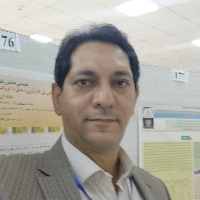Residual Effects of Some Sulfonylurea Herbicides of Wheat (Triticum aestivum L.) on Cotton (Gossypium hirsutum L.) in Conservational Tillage System
Author(s):
Article Type:
Research/Original Article (دارای رتبه معتبر)
Abstract:
Introduction
Cotton as a second crop is planted at some relatively warm and dry conditions in rotation after wheat, in Iran. In this situation, herbicide residue persistence is a determining factor for cotton production. Seven sulfonylurea herbicides were registered for weed control of wheat in Iran and some of them may have adverse residue effects on growth and yield of cotton. Sulfonylurea herbicides at very low doses, inhibit synthesis of essential amino acid such as leucine, iso-leucine, and valin in the sensitive plants. Many studies demonstrated that there is dangerous residue of sulfonylurea herbicide in a soil with high pH, low moisture and organic matter level, and with the short time between herbicide application and the emergence of the following crop. For example, 135 days after application of metsulfuron, triasulfuron, and chlorosulfuron, cotton biomass was reduced by 23% to 67% in a soil with pH ranged 7.8 to 8.6 (6). In the other studies, sulfosulfuron residue caused damage to barley, lens, sorghum, and sunflower as sensitive crop after one year (16, 20). Residue of triasulfuron (at 22 gr.ha-1) one year after application made injuries to alfalfa, canola, corn, potato and sugar beet (21).
Materials and Methods
This study was conducted during 2013-2014 to evaluate residue effects of some sulfonylurea herbicides of wheat on cotton at Sarakhs region of Iran. The soil textural class was silty clay with EC= 5.62 dS.m-1 and pH= 8.2. The field trial was a randomized complete block design with seven treatments in four replications. The treatments consisted of five sulfonylurea herbicide treatments as follows: 1- sulfosulfuron (26.6 g.ha-1 of Apyros® 75%WG), 2- mesosulfuron + iodosulfuron + mefenpyre (1.5 L.ha-1 of Atlantis® 1.2% OD), 3- triasulfuron + dicamba (165 g.ha-1 of Lenture® 70% WG), 4- triasulfuron + terbutryn (250 g.ha-1 of Logran Extra® 64% WG) and 5- metsulfuron + sulfosulfuron (40 g.ha-1 of Total® 75% WG). All herbicides applied in 3-5 leaf stage of wheat on 23th November, 2013. Furthermore, one herbicide free treatment (all season hand weeding) was considered as the control. Immediately after wheat harvest, cotton (Gossypium hirsutum L. var. Varamin) was planted (June 2, 2014) as the second crop in wheat spaces by a direct seeding machine. Residue effects on cotton plants were measured by plant height, stem length and dry matter (DM). Rankings of visual injury based on EWRC (European Weed Research Council) were recorded at four times starting seven days after cotton emergence. Cotton was harvested on September 26, 2014 and bull number, boll yield, and fiber yield were then determined. At the same time, residual bioassay tests were done in completely randomized design with four replications in the greenhouse using cotton, corn, barley, and canola. Their shoot and root dry matters were measured three weeks after emergence. Analysis of variance and mean comparisons (LSD 5%) was accomplished by SAS® (ver. 9.2) software.
Results and Discussion
The results showed herbicide residue from and sulfosulfuron and metsulfuron+ sulfosulfuron significantly reduced cotton plant height and dry matter in the field at the first time of sampling (30 days after emergence). However, the differences in plant heights were not significant at the second and third sampling time owing to growth compensation after crop fertilization. It seems that metsulfuron is more important than sulfosulfuron in cotton injury as responsible ingredient. According to the previous studies, half-life of metsulfuron was 52 days and for sulfosulfuron was 42 days in average (28). Both of them are more persistent in the soils with high pH and low organic matter like the soils in our experiment. Mesosulfuron + iodosulfuron + mefenpyre residue had somewhat adverse effects on early growth of cotton and reduced shoot dry weight, but after 50 days plants were recovered. According to Tomlin (28), half-life of mesosulfuron and iodosulfuron was reported 38 days and 8.5 days, respectively. No adverse effect was recognized in cotton plants from triasulfuron+ terbutryn and triasulfuron+ dicamba. Half-life is 19 days for triasulfuron and negligible for two other ingredients. The herbicides injures were not as much stable as cotton yields were significantly affected. In greenhouse bioassay experiment, cotton shoot DM was significantly reduced by residues of metsulfuron+ sulfosulfuron, sulfosulfuron and mesosulfuron+ iodosulfuron+ mefenpyre. In addition, residual effects of metsulfuron+ sulfosulfuron and sulfosulfuron were observed on cotton root DM. Adverse effects from metsulfuron+ sulfosulfuron and sulfosulfuron caused a significant reduction in barley. Both of these herbicides were registered for controlling of wild barley (Hordeum spontaneum K. Koch.) in wheat fields. The most residual injuries were observed in canola in which all traits were reduced by residues of herbicides used for wheat.
Conclusion
According to the field experiment, we found that the residues of two herbicides Total® 75% and Apyros® 75% lessened cotton height, dry matter of shoot and root at early growth stages. Nevertheless, the plant was recovered with season progress especially after overtop fertilization and consequently cotton yield (boll number, boll yield and fiber yield) was not significantly decreased. The results of pot experiment confirmed the field results and showed that these two herbicides significantly decreased cotton growth. Besides, growth of barley, canola and corn was affected by Total® 75%, Apyros® 75% and Atlantis® 1.2%. Therefore, metsulfuron and sulfosulfuron have the most effective residue among all components investigated. Moreover, canola and corn were, respectively, the most and least sensitive crops in the bioassay experiment.Keywords:
Barley , Bioassay , Canola , Corn , Second crop , Visual injury
Language:
Persian
Published:
Journal of plant protection, Volume:33 Issue: 1, 2019
Pages:
85 to 97
magiran.com/p2000579
دانلود و مطالعه متن این مقاله با یکی از روشهای زیر امکان پذیر است:
اشتراک شخصی
با عضویت و پرداخت آنلاین حق اشتراک یکساله به مبلغ 1,390,000ريال میتوانید 70 عنوان مطلب دانلود کنید!
اشتراک سازمانی
به کتابخانه دانشگاه یا محل کار خود پیشنهاد کنید تا اشتراک سازمانی این پایگاه را برای دسترسی نامحدود همه کاربران به متن مطالب تهیه نمایند!
توجه!
- حق عضویت دریافتی صرف حمایت از نشریات عضو و نگهداری، تکمیل و توسعه مگیران میشود.
- پرداخت حق اشتراک و دانلود مقالات اجازه بازنشر آن در سایر رسانههای چاپی و دیجیتال را به کاربر نمیدهد.
دسترسی سراسری کاربران دانشگاه پیام نور!
اعضای هیئت علمی و دانشجویان دانشگاه پیام نور در سراسر کشور، در صورت ثبت نام با ایمیل دانشگاهی، تا پایان فروردین ماه 1403 به مقالات سایت دسترسی خواهند داشت!
In order to view content subscription is required
Personal subscription
Subscribe magiran.com for 70 € euros via PayPal and download 70 articles during a year.
Organization subscription
Please contact us to subscribe your university or library for unlimited access!




